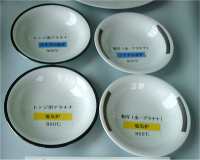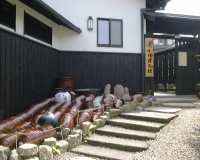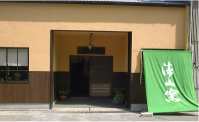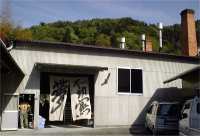 |
 |
| だち窯やまつり Visit to Dachi Kiln Festival [Photos taken on May 4, 2003] |
| 2003年5月4日岐阜県土岐市の県道66号(多治見〜恵那線)沿いの道の駅「どんぶり会館」 で案内絵図を頂き、駄知町の窯元を巡る「だち窯やまつり」に行きました。様子は下の 写真参照下さい。 After I received a guidance pictorial map at the road station, "Donburi Kaikan (or a Bowl Hall)" along Gifu prefectural road No.66 (Tajimi - Ena line) On May 4, 2003, I joined "Dachi Kamaya Maturi (or Dachi Pottery Festival)" to visit the pottery. Please see the photos for a situation. この道路を挟んで土岐市立陶磁器試験場「セラテクノ土岐」があります。セラテクノ土岐 の1階ロビーには土器、土師器、須恵器、陶磁器の成形工程、上絵付、下絵付、洋絵具、 和絵具、織部黒/黒織部の違いなどの興味ある説明が写真やイラストと一緒にあり、2階 展示ロビーにはマイクロ波による陶磁器焼成技術開発の説明がイラストと焼成サンプル でされております。(以下に【マイクロ波による陶磁器焼成技術開発】と【高強度磁器】の 概要を示します) また、土岐市陶磁器卸商業協同組合は官公需適格組合となっており、市、土岐市立 陶磁器試験場、業界が一体となって、陶磁器産業を育て、新技術の開発に取り組んで おられます。 There is a Toki Municipal Institute of Ceramics, "Ceratechno Toki" facing across the road. The first floor lobby in "Ceratechno Toki" has interesting explanation of the difference between the forming process of earthenware, Hajiki, Sueki, and pottery, overglaze, underglaze, Western style painting, Japanese style painting, the Oribe-guro/ Kuro-Oribe etc. together with a photograph or an illustration. The explanation on the technological development of ceramics firing by microwave is given at the second floor exhibition lobby with the illustration and the firing sample. The following is a summary on 【Technological development of ceramics firing by microwave 】and 【High strength ceramics】. The Toki pottery wholesale dealer business cooperative is an association suitanble for public demand. Toki City, Toki Municipal Institute of Ceramics, and the industry are united, the ceramic industry is raised, and the development of new technology is tackled. 《ウェブページ作成者コメント→瀬戸市は開発に真剣に取り組んでいるか?》 陶都瀬戸市には赤津地区を筆頭に、水野地区、品野地区、瀬戸市街に陶芸作家が拠点 を構え、窯元として作陶活動を精力的に行っており質的には日本一でしょう。 しかし、汎用・工業用陶磁器業界は新技術開発に土岐市ほどの取り組みをしているか? 名古屋工業研究所が行う技術開発を新商品開発・生産へ応用しているだろうか? 世界一の良質陶土と知名度にあぐらをかいて努力を怠っていないだろうか? 《comments of Web page writer→ Does Seto City tackle to development earnestly?》 Ceramic artists establish the bases at Akazu , Mizuno, Shinano and downtown in Seto City and are performing ceramics making activities energetically as pottery. The activity of the ceramic artists will be the best in contents and quality in Japan. Do the pottery industry for daily and industrial use tackle eagerly to new technical development like Toki City? Is the technical development which a Nagoya Industrial Research Institute performs applied to new product development and production? Doesn't Seto City rest on the No.1 good-quality china clay in the world and its notability, and neglect efforts? |
【マイクロ波による陶磁器焼成技術開発の概要】 |
| 目的:環境負荷低減型短時間・均質焼成加熱プロセスの開発 エネルギー多消費型から小消費型への転換 マイクロ波焼成→省エネ・CO2削減/コストダウン/焼成時間短縮/品質向上 Purpose: Short processing time to reduce the load against environment Development on equally firing and heating process Conversion from mass energy consumption style to a small one Microwave firing→ reduction of CO2 due to saving energy, cost decrease, shortening of firing time, quality improvement |
従来の焼成方法(外部加熱) |
マイクロ波焼成(自己発熱) |
| 輻射対流による外部からの加熱 External heat generation due to radiation and circulation |
発振器からのマイクロ波を攪拌機で散乱→ ステンレスの外壁がマイクロ波を反射→断熱材 (マイクロ波吸収少ない)を挟んでムライト製の炉 (製品と同じ性質の素材)に製品を収容→ 製品と炉壁が自己発熱→炉内は均一な温度分布 A stirrer scatters the microwave from an oscillator. → The outside wall of stainless steel reflects microwave. →Accommodating a product in the furnace made from MURAITO (same material as a product in characteristics) with a heat insulator (few absorption of microwave) being inserted between the furnace and the outside wall → Self-generation of heat of the product and the furnace wall → A uniform temperature distribution inside the furnace |
マイクロ波焼成方法 |
|
| マイクロ波焼成サンプル Sample by microwave firing |
| 金・プラチナ釉焼(電子レンジ用) 焼成時間 マイクロ波焼成
800℃ 1時間 電気炉焼成 800℃ 4時間 Firing with gold/platinum glaze (for microwave ovens) Firing time by microwave 800℃ 1 hour by electric furnace 800℃ 4 hours |
| 和絵具 焼成時間 マイクロ波焼成 800℃ 1時間 電気炉焼成 800℃ 4時間 Firing with Japanese style painting Firing time by microwave 800℃ 1 hour by electric furnace 800℃ 4 hours |
| 黄ラベル→電気炉 青ラベル→マイクロ炉 金・プラチナ 和絵具 Yellow label→ Blue label→ electric furnace microwave gold/platinum Japanese style painting |
|
 |
 |
| 【高強度磁器の概要】【High strength ceramics】 |
| 普通の陶磁器の3倍以上の強度を有する。 This has the strength of 3 times or more of ordinary ceramics. |
| 原料 Material |
アルミナ Alumina |
珪石 Silica ston |
長石 feldspar |
粘土類 Clay |
| 高強度磁器 high strengh porcelain |
30 | 0 | 30 | 40 |
| 一般白磁器 ordinary white porcelain |
0 | 30 | 30 | 40 |
| 成形方法: ローラーマシンによるロクロ成形 加熱方法: パッドプレス印刷機による下絵印刷及びイングレーズ 焼成方法: ガス炉、 1350℃還元焼成 *アルミナ(Al2O3) 原料のボーキサイトを粉砕し、苛性ソーダと混合、加圧加熱装置 で加圧、加熱すると、ボーキサイトに含まれているアルミナ分は苛性ソーダに溶けて アルミン酸ソーダとなり、水酸化アルミニウムの結晶として析出する。更にこの水酸化 アルミニウムを高温で焼くことにより、アルミナ(酸化アルミニウム)となる。 *パッドプレス 絵付技法の一つで、素焼きした器に、弾力性のあるシリコン樹脂パッドを押し付けて 絵柄を施し、施釉したのち、1300℃前後で焼成するもので、原理的にはゴム印刷と 同じ、1〜3色印刷が全面に一度に印刷できるのが特徴。 *イングレーズ 施釉上面に絵付けして、釉薬が溶融する温度(1200-1250℃)まで焼き、顔料(絵具) を釉薬の中に染み込ませる技法で、淡い色調が特徴。 Forming method: jolley forming by a roller machine Heating method: printing the underglaze-paintingt by the pad press printing machine and In-glaze Firing method: Reduction firing at 1350℃ in Gas furnace * Alumina (Al2O3) Grind a material, bauxite and mix it with caustic soda. Pressurize and heat the mixture with a pressurization heating equipment. Then Alumina contained in bauxite melts into caustic soda, becomes Alumi acid soda, and deposits as a crystal of aluminum hydroxide. Furthermore, when this aluminum hydroxide is burned at high temperature, it becomes alumina (aluminum oxide). * Pad-press This is one of painting (decoration) techniques. The procedure of this technique consists of pushing an elastic silicone resine pad to a biscuit ware, giving a pattern, applying a glazing agent and firing at around 1300 degrees C. Theoretically, this technique is the same as the one of rubber printing, and printing of 1 to 3 color is made at once on the whole surface. * In-glaze The procedure of this technique consists of painting on the glazed body, firing the painted body to the temperature 1200 to 1250 degree C (melting temperature of the glazing agent) and infiltrating the paint into the glaze. A light color tone is the feature. |
| 2003年5月4日土岐美濃焼まつりに行こうと思い、車を走らせたら「どんぶり会館」に到着。 時間の都合もあり、同じ土岐市内で催されている「だち窯やまつり」に方向転換し、まつりに 参加している8軒の窯元の内5軒を巡ってきました。清山窯に販売用展示の織部のビール カップの色合いが涼しげな緑でしかも安価で感動しました。他の窯元の製品は全体的に小生 の価値観からするとやや高い。藤山窯ではご主人の加藤賢治氏の友人という方から熱心に 説明を受け、勉強になりました。 I drove to "Toki Mino Ware Festival" but arrived at "Donburi Kaikan (or a Bowl Hall)" along Gifu prefectural road No.66 on May 4, 2003. For reasons of my own time, I changed my course to another festival held in Toki City, "Dachi Kamaya Maturi (or Dachi Pottery Festival)". I visited five in the eight potteries which has participated in this festival. The tone of the beer cup with Oribe glaze exhibited for sale at Seizan kiln was cool green, and moreover was cheap, and attracted me very much. On the whole, the ceramics of the other potteries are a little expensive, considering my sense of values. At Touzan kiln, I was eagerly explained by a friend of the potter, Mr. Kenji Kato, and I learned much. |
| 南楽窯 | 清山窯 | 不動窯 |
 |
 |
 |